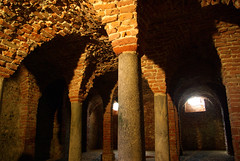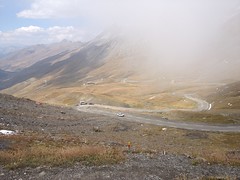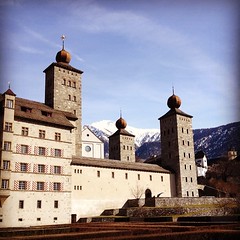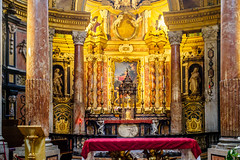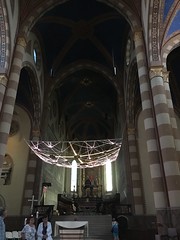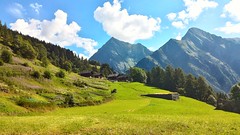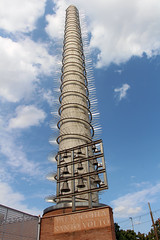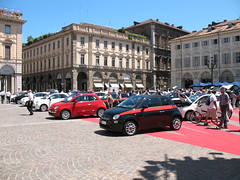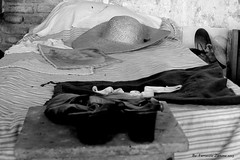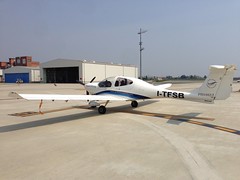Piedmont
Piedmont (English: /ˈpdmɒnt/ ; Italian: Piemonte, Italian: [pjeˈmonte]) is a region of Northwest Italy, one of the 20 regions of the country. It borders the Liguria region to the south, the Lombardy and Emilia-Romagna regions to the east and the Aosta Valley region to the northwest; it also borders Switzerland to the northeast and France to the west. It has an area of making it the second largest region of Italy after Sicily and a population of 4,269,714 as of 31 January 2021. The capital of Piedmont is Turin.
Toponymy
The French Piedmont, the Italian Piemonte, and other variant cognates come from the medieval Latin or , i.e., , meaning "at the foot of the mountains" (referring to the Alps), attested in documents from the end of the 12th century.
Geography
Piedmont is surrounded on three sides by the Alps, including Monviso, where the river Po rises, and Monte Rosa. It borders with France (Auvergne-Rhône-Alpes and Provence-Alpes-Côte d'Azur), Switzerland (Ticino and Valais) and the Italian regions of Lombardy, Liguria, Aosta Valley and for a very small part with Emilia Romagna. The geography of Piedmont is 43.3% mountainous, along with extensive areas of hills (30.3%) and plains (26.4%).
Piedmont is the second largest of Italy's 20 regions, after Sicily. It is broadly coincident with the upper part of the drainage basin of the river Po, which rises from the slopes of Monviso in the west of the region and is Italy's largest river. The Po drains the semicircle formed by the Alps and Apennines, which surround the region on three sides.
The countryside is very diverse: from the rugged peaks of the massifs of Monte Rosa and Gran Paradiso to the damp rice paddies of Vercelli and Novara, from the gentle hillsides of the Langhe, Roero and Montferrat to the plains. 7.6% of the entire territory is considered protected area. There are 56 different national or regional parks; one of the most famous is the Gran Paradiso National Park, between Piedmont and the Aosta Valley.
Piedmont has a typically temperate climate, which on the Alps becomes progressively temperate-cold and colder as it climbs to altitude. In areas located at low altitudes, winters are relatively cold but not very rainy and often sunny, with the possibility of snowfall, sometimes abundant. Snowfall, on the other hand, is less frequent and occasional in the northeast areas. Summers are hot with local possibilities of strong thunderstorms.
Major towns and cities
| Population rank | City Name | Population (ab) | Surface (km2) | Density (ab/km2) | Altitude (m s.l.m) | Province or metropolitan city |
|---|---|---|---|---|---|---|
| 1 | Turin | 875,698 | 130.17 | 6,786 | 239 | TO |
| 2 | Novara | 104,411 | 103.05 | 1,013 | 162 | NO |
| 3 | Alessandria | 93,884 | 203.97 | 460 | 95 | AL |
| 4 | Asti | 76,424 | 151.82 | 504 | 123 | AT |
| 5 | Moncalieri | 57,060 | 47.63 | 1,197 | 260 | TO |
| 6 | Cuneo | 56,116 | 119.88 | 468 | 534 | CN |
| 7 | Collegno | 49,940 | 18.12 | 2,756 | 302 | TO |
| 8 | Rivoli | 48,819 | 29.52 | 1,653 | 390 | TO |
| 9 | Nichelino | 48,182 | 20.64 | 2,334 | 229 | TO |
| 10 | Settimo Torinese | 47,704 | 32.37 | 1,473 | 207 | TO |
Other towns of Piedmont with more than 20,000 inhabitants sorted by population :
| Population rank | City Name | Population (ab) | Surface (km2) | Density (ab/km2) | Altitude (m s.l.m) | Province or metropolitan city |
|---|---|---|---|---|---|---|
| 11 | Vercelli | 46,808 | 79.85 | 586 | 130 | VC |
| 12 | Biella | 44,860 | 46.68 | 961 | 417 | BI |
| 13 | Grugliasco | 37,906 | 13.12 | 2,889 | 293 | TO |
| 14 | Chieri | 36,778 | 54.30 | 677 | 305 | TO |
| 15 | Pinerolo | 35,778 | 50.28 | 711 | 376 | TO |
| 16 | Casale Monferrato | 34,565 | 86.32 | 400 | 116 | AL |
| 17 | Venaria Reale | 34,248 | 20.29 | 1,687 | 262 | TO |
| 18 | Alba | 31,419 | 54.01 | 581 | 172 | CN |
| 19 | Verbania | 30,933 | 36.62 | 844 | 197 | VB |
| 20 | Bra | 29,705 | 59.61 | 498 | 285 | CN |
| 21 | Carmagnola | 29,052 | 96.38 | 301 | 240 | TO |
| 22 | Novi Ligure | 28,257 | 54.22 | 521 | 199 | AL |
| 23 | Tortona | 27,575 | 99.29 | 278 | 122 | AL |
| 24 | Chivasso | 26,704 | 51.31 | 520 | 183 | TO |
| 25 | Fossano | 24,743 | 130.72 | 189 | 375 | CN |
| 26 | Ivrea | 23,598 | 30.19 | 781 | 253 | TO |
| 27 | Orbassano | 23,240 | 22.05 | 1,053 | 273 | TO |
| 28 | Mondovì | 22,592 | 87.25 | 258 | 395 | CN |
| 29 | Borgomanero | 21,709 | 32.36 | 670 | 307 | NO |
| 30 | Savigliano | 21,306 | 110.73 | 192 | 321 | CN |
| 31 | Trecate | 20,329 | 38.38 | 529 | 136 | NO |
| 32 | Acqui Terme | 20,054 | 33.30 | 602 | 156 | AL |
History
Piedmont was inhabited in early historic times by Celtic-Ligurian tribes such as the Taurini and the Salassi. They were later subdued by the Romans (c. 220 BC), who founded several colonies there including Augusta Taurinorum (Turin) and Eporedia (Ivrea). After the fall of the Western Roman Empire, the region was successively invaded by the Burgundians, the Ostrogoths (5th century), East Romans, Lombards (6th century), and Franks (773).
In the 9th–10th centuries there were further incursions by the Magyars, Saracens and Muslim Moors. At the time Piedmont, as part of the Kingdom of Italy within the Holy Roman Empire, was subdivided into several marches and counties.
In 1046, Otto of Savoy added Piedmont to the County of Savoy, with a capital at Chambéry (now in France). Other areas remained independent, such as the powerful comuni (municipalities) of Asti and Alessandria and the marquisates of Saluzzo and Montferrat. The County of Savoy became the Duchy of Savoy in 1416, and Duke Emanuele Filiberto moved the seat to Turin in 1563. In 1720, the Duke of Savoy became King of Sardinia, founding what evolved into the Kingdom of Sardinia and increasing Turin's importance as a European capital.
The Republic of Alba was created in 1796 as a French client republic in Piedmont. A new client republic, the Piedmontese Republic, existed between 1798 and 1799 before it was reoccupied by Austrian and Russian troops. In June 1800 a third client republic, the Subalpine Republic, was established in Piedmont. It fell under full French control in 1801 and it was annexed by France in September 1802. In the Congress of Vienna, the Kingdom of Sardinia was restored and furthermore received the Republic of Genoa to strengthen it as a barrier against France.
Piedmont was a springboard for Italian unification in 1859–1861, following earlier unsuccessful wars against the Austrian Empire in 1820–1821 and 1848–1849. This process is sometimes referred to as Piedmontisation. However, the efforts were later countered by the efforts of rural farmers.
The House of Savoy became Kings of Italy, and Turin briefly became the capital of Italy. However, when the Italian capital was moved to Florence, and then to Rome, the administrative and institutional importance of Piedmont was reduced. The only recognition of Piedmont's historical role was that the crown prince of Italy was known as the Prince of Piedmont. After Italian unification, Piedmont was one of the most important regions in the first Italian industrialization.
Demographics
| 31 December 2018 largest resident foreign citizens groups | |
|---|---|
| Country of birth | Population |
| Romania | 147,916 |
| Morocco | 54,151 |
| Albania | 40,919 |
| China | 20,091 |
| Nigeria | 12,638 |
| Peru | 11,579 |
| Ukraine | 10,435 |
| Moldova | 8,945 |
| Egypt | 7,889 |
| Senegal | 7,626 |
| North Macedonia | 6,463 |
| Philippines | 6,309 |
| India | 5,301 |
| Pakistan | 5,084 |
The population density in Piedmont is lower than the national average. In 2008 it was equal to 174 inhabitants per km2, compared to a national figure of about 200. The Metropolitan City of Turin has 335 inhabitants per km2, whereas Verbano-Cusio-Ossola is the least densely populated province, with 72 inhabitants per km2.
The population of Piedmont followed a downward trend throughout the 1980s, a result of the natural negative balance (of some 3 to 4% per year), while the migratory balance since 1986 has again become positive because of immigration. The population remained stable in the 1990s.
The Turin metro area grew rapidly in the 1950s and 1960s due to an increase of immigrants from southern Italy and Veneto and today it has a population of approximately two million. , the Italian national institute of statistics (ISTAT) estimated that 310,543 foreign-born immigrants live in Piedmont, equal to 7.0% of the total regional population. Most immigrants come from Eastern Europe (mostly from Romania, Albania, and Ukraine) with smaller communities of African immigrants.
Culture
Languages
As in the rest of Italy, Italian is the official national language. The main local languages are Piedmontese, Insubric (spoken in the eastern part of the region), Occitan (spoken by a minority in the Occitan Valleys situated in the Province of Cuneo and the Metropolitan City of Turin), and Franco-Provençal (spoken by another minority in the alpine heights of the Metropolitan City of Turin), like in the Susa valley and Walser (spoken by a minority in the Province of Vercelli and Province of Verbano-Cusio-Ossola).
General sources
- Collier, M. (2003). Italian Unification, 1820–71. Heinemann: Oxford. .
External links
Looking for places related to Piedmont?
Those are other destinations to find places related to Piedmont:





